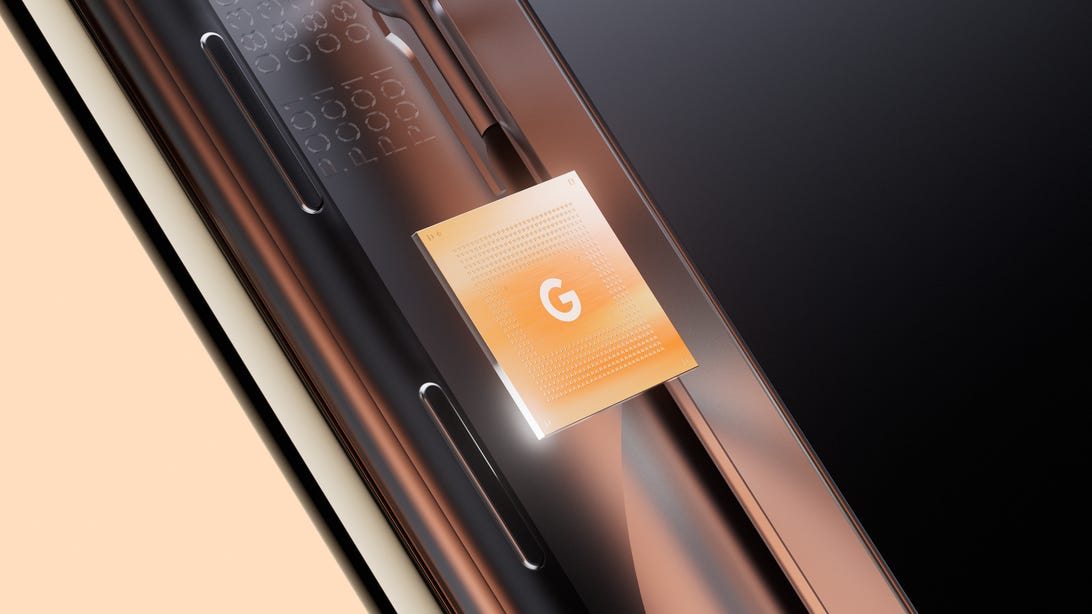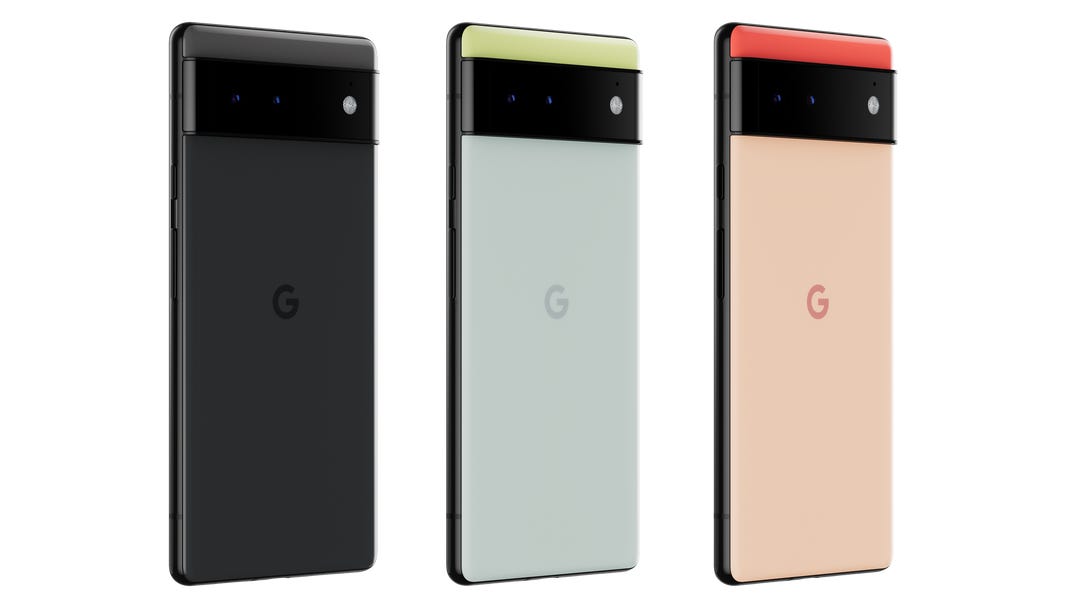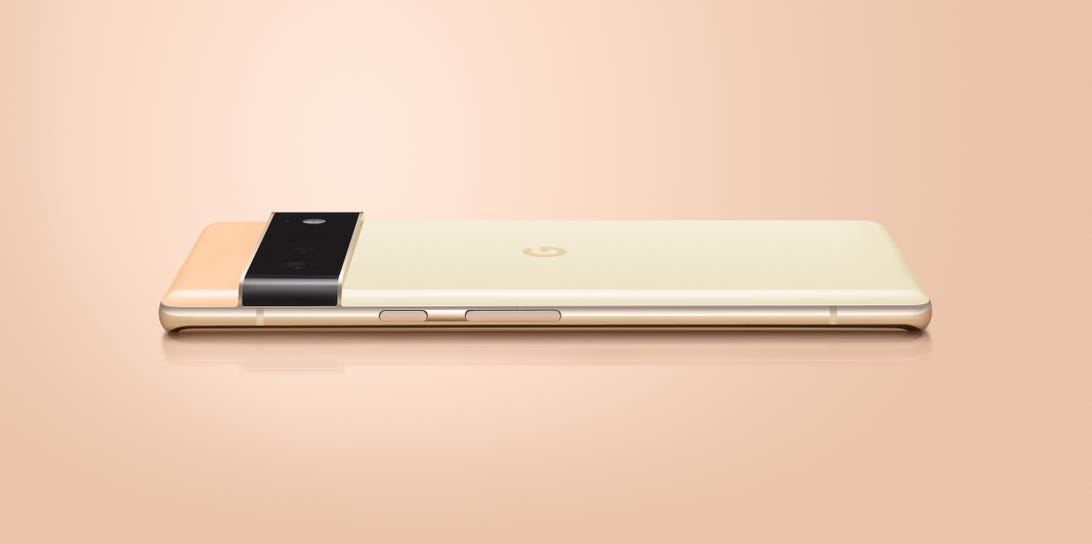
Google’s Pixel 6 phones will come in several colors.
Google unveiled on Monday the newest generation of its flagship phone line, the Pixel 6 and Pixel 6 Pro, to compete in a crowded field dominated by Apple and Samsung. The 5G phones, which will launch in the fall, are powered by a new system-on-chip that Google designed in-house.
Like most Android phone makers, Google has long relied on Qualcomm’s SOCs to power its devices. But designing its own processor to serve as the brains of the device allows Google to better customize the chip for the features it deems most important. The new chip, called Tensor, can punch up computing power and bolster the video capabilities of Pixel phones, juicing features that lagged behind those of rivals in previous Pixel models.
The new chip is only part of a major overhaul of Google’s phones. The most notable hardware change is a black camera strip toward the top of the phone that runs along the width of the back. By contrast, the camera on last year’s phone was housed in a small square on the top left corner of the back. Both phones have a new sensor that takes in 150% more light than the Pixel 5, as well as an ultrawide lens. The 6 Pro has an additional telephoto lens with 4-times optical zoom.
The phones are also more colorful than previous models, with pastel schemes in green, blue, pink, and more. The Pixel 6 has a 6.4-inch display that stretches across the front of the device, while the 6 Pro’s screen is 6.7 inches. Both are larger than last year’s 6-inch Pixel 5.
Prices and specific release dates haven’t been released yet. The predecessor Pixel 5 started at $699 and launched in October.
The Pixel 6 lineup faces serious pressure as Google continues to struggle in the premium phone market. When it comes to smartphone software, Google’s Android is the world’s most widely used mobile operating system, powering almost nine out of every 10 smartphones shipped globally. But the company hasn’t managed to gain traction with its own branded phones, and sales have been lackluster for years. Google executives have in the past blamed the slow uptake on fierce competition in a premium phone market led by Apple and Samsung.

Google designed its own system-on-a-chip called Tensor.
In the US, no companies have been able to compete with the two giants. In the second quarter of 2021, Pixel owned 0.7% of the market, down from 1.3% during the same period a year earlier, according to Strategy Analytics. Still, Google has defended its decision to continue investing in high-end phones.
“Part of the goal is to show the very best that Google can offer,” Rick Osterloh, senior vice president of Google’s hardware division, said in an interview last week. “There is a big segment of the market that wants the latest, and we love building technology. So we’re going to try to appeal to that part of the market, too.”
The move for Google to design the Pixel’s chip comes as other tech giants have taken more steps to develop the brains of their devices, not just the software and hardware.
Samsung has long made components for some of its devices, and Microsoft partnered with Qualcomm to design a processor for its Surface devices. Apple, in particular, has benefited from using its own chips in everything from its iPhones to its Macs. Apple’s in-house development has allowed it to focus on making its processor powerful but also energy efficient. Apple’s M1 computer silicon, which arrived in November in some Macs, is twice as powerful as a rival laptop chip and consumes a quarter of the battery life, Apple said when it unveiled the computers.
For Google, the boost in computing power from the Tensor chip will also enable better artificial intelligence on Pixels. That includes improved speech recognition, like dictation for texts, and more high-end photography, like software upgrades that makes photos less blurry. “This is the biggest innovation in Pixel we’ve made to date, designed in collaboration with our AI and Android teams to deliver the best experience at the intersection of hardware, software and AI for years to come,” Google CEO Sundar Pichai said in a statement.
Qualcomm, which supplied chips to Google for previous Pixel models, downplayed the move, adding that its Snapdragon processor remains “synonymous” with Android phones. “Qualcomm Technologies and Google have been partners for more than 15 years starting with bringing the first Android devices to market,” a spokeswoman said in a statement. “We will continue to work closely with Google on existing and future products based on Snapdragon platforms to deliver the next-generation of user experiences for the 5G era.”
Tensions in the ‘distant past’
Selling devices has become a crucial endeavor for Google because people access the internet from more places than their desktop computers, the primary point of contact when the tech giant was founded more than two decades ago. Now people are telling smart speakers to play curated playlists, using phones to order takeout or creating jogging routes with mapping apps.

The phones have a camera strip that runs along the back.
The more Google knows about people and their interests, the more valuable its ads become to marketers who pay the company to target potential buyers based on their likes, dislikes, age, interests and location. The company’s massive digital advertising operation, which has been under investigation by antitrust regulators, generates the vast majority of Google’s more than $180 billion in annual sales.
A major turning point for Google’s hardware operation came five years ago, when the company tapped Osterloh, the former president of Motorola, to lead a dedicated team focused on creating consumer devices. A year later, Google paid $1 billion to bulk up its hardware engineering ranks through a deal with Taiwanese manufacturer HTC.
The Pixel 6 announcement comes after Google’s phone team faced shakeups and turmoil following the release of previous models. Osterloh reportedly criticized product decisions made during development of the Pixel 4, which had lackluster sales. Mario Queiroz, the former head of the Pixel division, departed the company last year after leaving the smartphone team the year before. Marc Levoy, who built Google’s smartphone software into a leader in mobile photography, also left last year.

Google will announce prices for its phones in the fall.
Levoy, who now works at Adobe, is known as a trailblazer in “computational photography,” which relies on software to improve images. He helped pioneer several camera features for the Pixel, including Portrait Mode, which glams up smartphone photos to make them look professionally shot, and Night Sight, which brightens pictures in low light. Many of the features he built for the search giant have been applauded by reviewers and consumers and have eventually ended up on competing devices, like Apple’s iPhones.
Osterloh declined to comment about the tensions in the Pixel division, only saying they were in the “distant past.” Google has since reorganized the division, and Osterloh now heads up the Pixel unit, in addition to his role overseeing the broader Google hardware group, he told CNET.
As Google continues to struggle in the premium mobile device market, it faces criticism about how seriously it wants to be in the phone business — or if it’s just an expensive hobby.
“We don’t usually talk about profit and loss,” Osterloh said. “But our aim is not to lose money on this. We certainly try to manage this like a business.”





